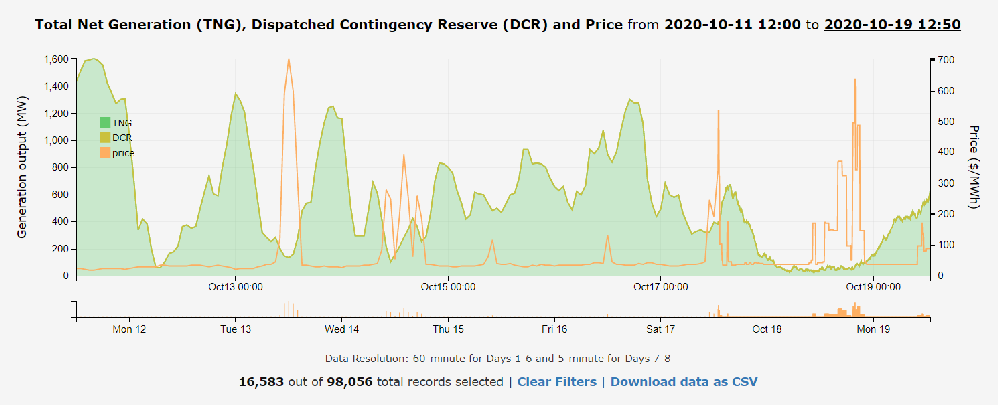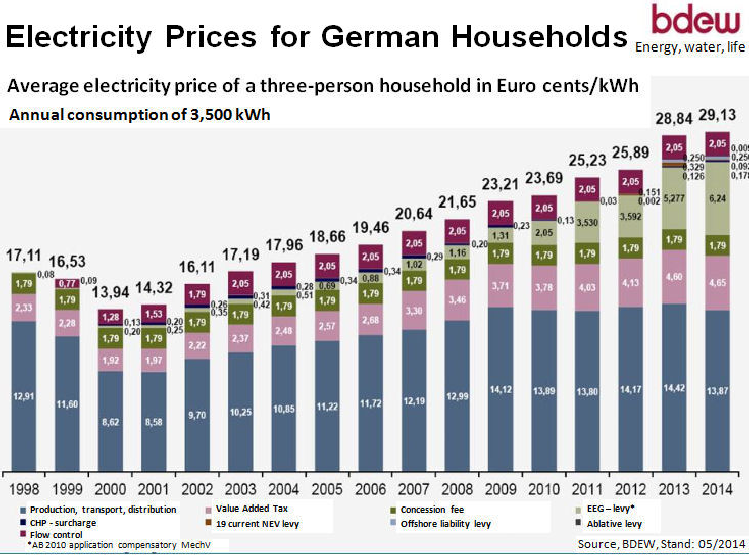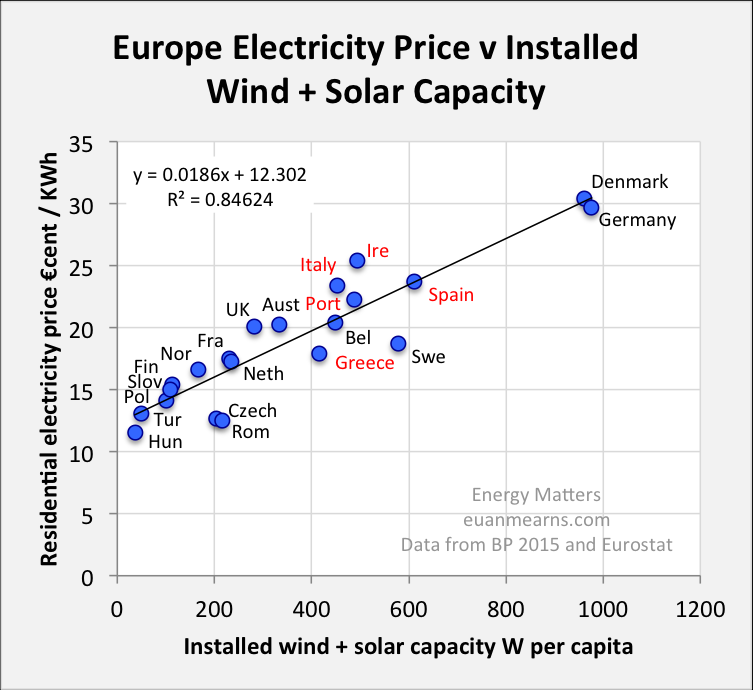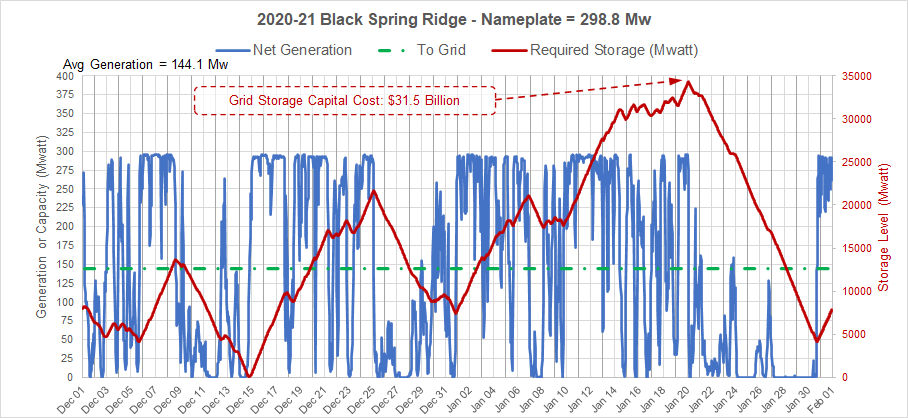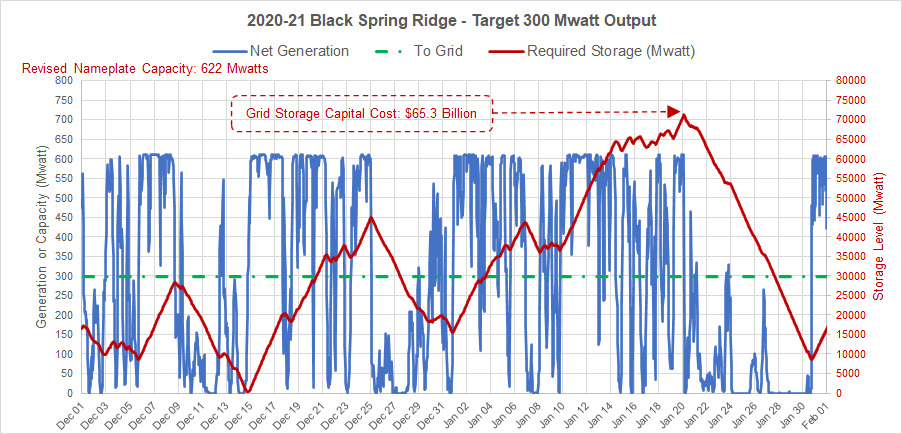Renewable Wind Power is promoted as a key strategy for a Green Canada
Do we understand ALL the implications of what that means?
Wind Power is a viable technology and is a good fit for many applications. However, used for Major Utility Generation, it has critical limitations.
Wind Power Facts....
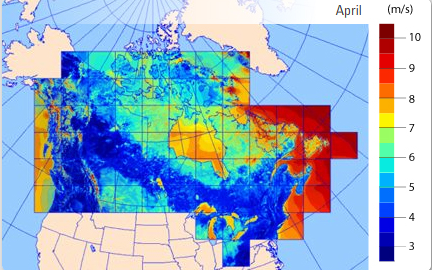 Total Power Produced by wind turbines is affected by:
Total Power Produced by wind turbines is affected by:
- Wind Speeds. Wind turbines typically require
- A minimum wind speed of 3.3 m/s (12 kph) to 3.9 m/s (14 kph) to begin turning and generating power.
- Strong winds of 13.8 m/s (50 kph) to 16.7 m/s (60 kph) to generate at full capacity.
- Winds less than 26 m/s (90 kph). Beyond that speed, the turbines must be stopped to avoid damage.
- Average Wind Speeds have a direct impact on the capital cost of a project. The lower the potential, the more turbines are needed to achieve the design power output.
- Wind turbines require significantly more maintenance than solar systems. Blades deteriorate due to erosion as air flows over them. Gearboxes, Generators and other Moving Equipment require regular service and replacement.
- The design life of a good quality modern wind turbine is 20 years. Depending on how windy and turbulent the site is, the turbine could last for 25 years, though as with anything mechanical, the maintenance costs will increase as it gets older.
- Wind capabilities in Canada average close to 25%. Marginally better than solar, but still not high enough to be viable
How Will This Impact Every Canadian?
- Different locations will have different economics. The lower the average winds, the more wind turbines are needed.
- Typical generation profile for Wind Farms in Alberta Source.
- There is more to the story than reduced power generation
- Wind turbines frequently injure or kill birds and bats. People who live in close proximity complain of the noise which in some cases has driven people from their homes.
- No ability to increase production to meet system demand.
- Typically, wind speeds are lower at night than during the day.
- It is difficult to predict power generation further than a few hours into the future.
- Observing a wind turbine will not tell you how much power it is producing.
- A wind turbine will turn at the same speed as every other one because it is sychronized into the power distribution grid. If you count the number of rotations per minute, it will always be a function of 60.
- The amount of power the wind turbine is putting out is dependant on the force exerted as air flows over the blades. This will vary due to the angle of the blades and the actual wind hitting the turbine.
- Consider 2 cases for installing wind generation when there is surplus Fossil Fuel Fired capacity :
- Case 1 - System Demand will not be impacted because any reduction in Wind Generation can be made up for by facilities burning Fossil Fuel. This is referred to as "spinning reserve". In this case CO2e emissions reduction will be proportional to Wind Generation. The justification and economics for this case are poor. You cannot eliminate the spinning reserve and the only savings will be from small reductions in fossil fuel consumption. There will be no savings through reduced manpower or other operating costs.
- Case 2 - Hydro and Nuclear power can function as spinning reserve. However, there will be no reduction in emissions as these sources are considered to be renewable. Most importantly, why would you install wind turbines if you already have zero emission generation capacity? There are no economics to this case.
- Case 3 - If the current system is unable to meet demand and new capacity must be added, some might push for Wind Power because it is perceived to be totally renewable.
- To avoid brown-outs and/or black-outs, an equivalent amount of spinning reserve must to be added.
- If the spinning reserve is fossil fuel, then there is limited advantage in reducing emissions.
- Natural Gas spinning reserve provides the best economics and is the cleanest alternative emissions wise.
- Hydro is a viable option but does not respond as quickly to demand changes. Canada is known for it's hydro capability with 3864 MW under construction and another 460 MW planned.
- Constructing a new hydro facility is very expensive, has a long lead time before power can be generated and in many cases can have significant environmental impacts. The creation of the necessary reservoir may displace individuals or even entire towns and communities.
- If hydro is selected for spinning reserve, it destroys the economics for wind. Why install wind turbines if you are already installing a renewable resource?
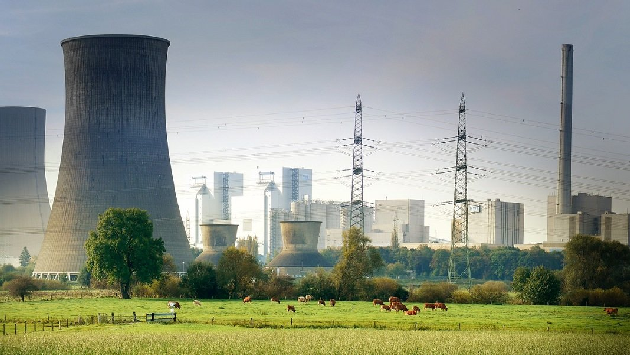 The only other technically proven and reliable source for renewable energy is nuclear power.
The only other technically proven and reliable source for renewable energy is nuclear power.- The lead time for building a nuclear plant requires an extended planning and design stage. It requires extensive consultations with impacted parties and would not be an easy sell. One estimate puts lead time as high as 15 years.
- Nuclear power is very safe. However, accidents if they do happen can be dramatic!
- Nuclear power is not 100% emission free because Uranium fuel must be mined, processed and transported.
- A major challenge is then the disposal of spent fuel. Uranium fuel is used up in approximately 18 months. It require secure storage in deep pools of circulating water to cool down for 10 years. It continues to remain dangerously radioactive for many years.
- There is a lot of misunderstanding surrounding nuclear power. Check out information from the World Nuclear Association.
- The future - A lot of work is being done to develop alternative renewable energy sources. A breakthrough is not expected in the near future. Unfortunately for the taxpayer, the objective of many research projects tends more toward keeping researchers employed and funds available to universities and development companies. The definition of success on these projects is often a Very Low Bar which taxpayers might view differently!
The Bottom Line: Every Canadian will see their costs increase to breaking point!
- In the excitement to embrace Wind Power it is easy to lose sight of how it will affect the cost of everything for Canadians
- Our society and the way of life we currently enjoy was built on fossil fuels.
- Hydrocarbons are an energy rich fuel source that can be produced inexpensively.
- Replacing $1.00 of Natural Gas with electricity currently costs between $5.21 and $13.88 at todays prices depending on your location.
- As we attempt to abandon fossil fuels by switching to electricity, these additional costs will be passed down to the consumer and taxpayer.
- It is not as simple as just adding generation capacity as people switch to electricity to heat their homes and power their cars. This increased demand will require major upgrades to the distribution system from the generation facility to our homes. This must be paid for by the consumer and/or taxpayer. See how the cost of electricity in Germany has increased as they expand solar & wind power generation.
- Everything will cost substantially more. We will see increased costs for utility bills to heat our homes, groceries, goods and services, new & old homes and new vehicles to mention a few.
- For an overview on the economics behind Wind (or Solar), see Renewable Economics 101
- As costs for everything increase, the disposable income of Canadians will fall.
- The current lifestyle of all Canadians will fall to a new low.
- The impact on our society will be huge.
- As disposable incomes fall and spending decreases, many businesses will fail or down-size. Unemployment numbers will soar setting up a vicious circle of lost income followed by less spending and even more unemployment.
- As Canadians are pushed to the limit by increasing costs and decreasing lifestyle, we will turn inward and there will be a marked increase in racial tensions, anti-immigration rhetoric and a return to tribalism. In a few short years, we will undo much of what are parents and grandparents worked so hard to build. We will lose much of what makes us proud to be a Canadian!
- Other countries will lose respect for us as we deteriorate to 3rd world status.
Read more about how Canadians will be hurt without any significant change in global CO2e emissions. Click Here
Think Wind Power is NetZero? Click Here
At some point in the future, if Canada remains on it's current path, costs will rise to a point where Canadians will be forced to say "ENOUGH"!
There will be a ground swell of support for abandoning the "Green Future" and return to the standard of living that we have earned through hard work and effort.
Is it not better to do that TODAY rather than later when much of the damage has been done? Speak up and make your voice heard.
A Case Study of Wind Energy in Alberta - The cost of reliable and consistent wind energy.
A copy of this case-study is available at: Click Here
- During a typical 2 month period, hourly data was collected from the Black Springs Ridge 1 Wind Project, the largest wind farm in Alberta (298.8 Mwatts). The average net generation was 144.1 Mwatt or 48.2% of nameplate capacity.
- The Maximum and Minimum generation ranged from 0 Mwatt to 295 Mwatt. There was no control of generation as it depended directly on the wind conditions at the time.
- Shown below is the amount of energy storage that would be required during the period to consistently meet demand if thermal generation backup was not available. It is important to note that this is a minimum and does not account for storage system efficiency.
- Peak storage required was 34,361 Mwatts.
- As shown in (Link) the cost of utility scale batteries today are $917,500 per Mwatt.
- The cost of storage would be $31.5 Billion
- The next graph shows the facility expansion and storage required to consistently and reliably meet nameplate capacity (300 Mwatts).
- To support storage, the facility must be able to generate sufficient energy to supply the grid PLUS add to storage to cover periods when generation drops off due to lower wind conditions.
- For this specific period, the number of Wind Turbines would have to be increased from 166 to 346 Units. This is a 108% increase. This would required additional Capex for the Turbines, Addition Land and Supporting Infrastructure. The original construction costs were $600 Million, so conservatively, it would cost at least this much again, just for the Wind Turbine expansion.
- Peak storage required would increase to 71,225 Mwatts.
- As shown in (Link) the cost of utility scale batteries are $917,500 per Mwatt at todays prices.
- The cost of storage would be $65.3 Billion

